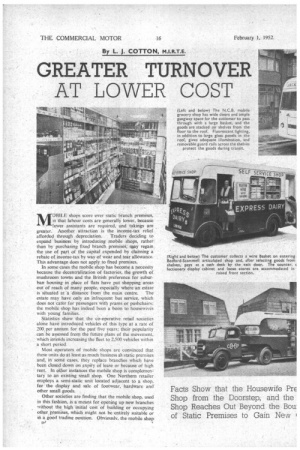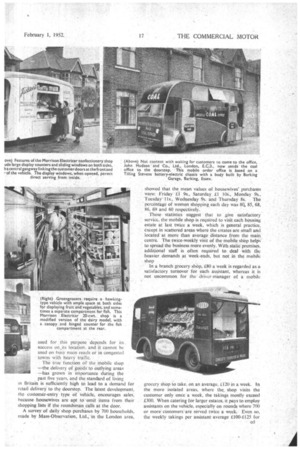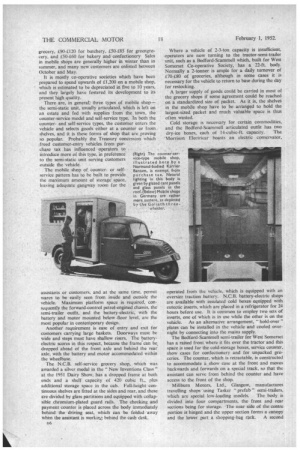GREATER TURNOVER AT LOWER COST
Page 44

Page 45

Page 46

Page 47

If you've noticed an error in this article please click here to report it so we can fix it.
By L. J. COTTON, M.I.R.T.E.
• 0131LE shops score over static branch premises, . ,.in that labour costs are generally lower, becauSe . ,.. fewer assistants are 'required, and takings are greater." Another attraction is the income-tax relief afforded through depreciation. Traders deciding to expand business by introducing mobile shops, rather than by purchasing fixed branch premiseS; may regain.. the use of part of the capital expended by claiming a rebate of income-tax by way of wear and tear allowance; This advantage does not apply to fixed premises.
In some cases the mobile shop has become a necessity because the decentralization of factories, the growth of. mushroom towns and the British preference for suburban housing in . place of flats have put shopping areas out of reach of many people, especially where an estate is Situated at 'a distance from the main centre. The estate may have only an infrequent bus service, which does not cater for passengers with prams or pushchairs; the mobile shop has indeed been a boon to housewives with young families. , Statistics show that the co-operative retail societies alone have introduced vehicles of this type at a rate of 200: per annum for the past five years; their popularity can.be assessed from the future plans of the movement,. which intends increasing the fleet to 2,500 vehicles within a short period.
Most operators of mobile shops are convinced that these units do atleast as much business A static premises. and, in' some cases, they replace branches which have been Closed down on .expiry of lease or 'because of high rent.. In other instances the mobile shop is complemen; tary to .an existing small shop. One Northern retailer employs a semi-static unit located adjacent to a shop, for the display and sale of footwear, hardware and other small goods.
Other societies are finding that the mobile shop, used in this fashion, is a means for opening up new branches without the . high 'initial cost of building or occupying other premises, which, might hot be entirely suitable or trt a good tradina oosition. Obviously, the mobile shop De
,used for. this purpose depends for its. success on ,its location, and it cannot be tted on busy main roads or in congested towns with heavy traffic.
The true function of the mobile shop —the delivery of goods to outlying areas —has grown in importance during the past five years, and the standard of living in Britain is sufficiently high to lead to a demand for retail delivery to the doorstep. The latest development, thp customer-entry type of vehicle, encourages sales', because housewives are apt to omit items from their shopping lists if the routidsman.calls at the door. A survey of daily shop purchases by 700 households, made by Mass-Observation, Ltd., in the London area,
showed that the mean values of housewives' purchases were: Friday £1 9s., Saturday 10s., Monday 9s., Tuesday I is., Wednesday 9s. and Thursday 8s. The percentage of women shopping each day was 8Q, 85, 68, 86. 69 and 60 respectively.
These statistics suggest that to give satisfactory service, the mobile shop is required to visit each housing estate at last twice a week, which is general practice, except in scattered areas where the estates are small and located at more than average distance from the main centre. The twice-weekly visit of the mobile shop helps to spread the business more evenly. With static premises, additional staff is often required to deal with the heavier demands at week-ends, but not in the mobile shop in a branch grocery she!), £80 a week is regarded as a satisfactory turnover for each assistant, whereas it is not uncommon for the driver-manager of a mobile grocery shop to take. on an average, £120 in a week. in the more isolated areas, where the shop visits the customer only once a week, the takings mostly exceed £300. When catering for larger estates, it pays to employ assistants on the vehicle, especially on rounds where 700 or more clistomers are served twice a week. Even so, the weekly takings per assistant average £100-£125 for grocery, £90-£120 for butchery, £50-£85 for greengrocery, and f50-£60 for bakery and confectionery Sales in mobile shops are generally higher in winter than in summer, and many new customers are enlisted between October and May.
It is mostly co-operative societies which have been prepared to spend upwards of £1,200 on a mobile shop, which is estimated to be depreciated in five to 10 years, and they largely have fostered its development to its present high quality.
There are, in general; three types of mobile shop— the semi-static unit, usually articulated, which is left on an estate and fed with supplies from the. town, the counter-service model and self-service type. In both the counterand self-service types, the customer enters the vehicle and selects goods either at a counter or front. shelves, and it is these forms of shop that are proving so popular. Probably the Treasury concession which freed customer-entry vehicles from purchase tax has influenced operators. to introduce more of this type, in preference to the semi-static unit serving customers
outside the -vehicle.
1-he mobile. shop of counteror selfservice pattern has to be built to provide the maximum amount of storagespace, leaving adequate gangway room for the
assistants or customers, and at the same time, permit wares to be easily seen from inside and outside the vehicle. Maximum platform space is required, consequently the forward-control petrol-engined chassis, the semi-trailer outfit, and the battery-electric, with the battery and motor mounted below -floor level, are the most popular in conteniporary design.
Another requirement. is ease of entry and exit for customers carrying large baskets. Doorways must be wide and steps must have shallow risers. The batteryelectric scores in this respect, because the frame can be, dropped ahead of the front axle and behind the rear axle, with the battery and motor accommodated within the wheelbase.
The N.C.B. self-service grocery shop, which was awarded a silver medal in the "New Inventions Class" at the 1951 Dairy Show, has a dropped frame at both ends and a shelf capacity of 420 cubic ft., plus additional storage space in the cab. Full-height continuous shelves are fitted at the sides and rear, and these are divided by glass partitions and equipped with collapsible chromium-plated guard rails. The checking and payment counter is placed across the body immediately behind • the driving seat, which can be folded away When the assistant is workirz behind the cash desk. Where a vehicle of 2-3-ton capacity is insufficient, operators are now turning to the tractor-semi-trailer unit, such as a Bedford-Scammell which, built for West Somerset Co-operative Society, has a 22-ft. body. Normally a 2-tonner is ample for a daily turnover of £70-£80 of groceries, although in some cases it is necessary for the vehicle to return to base during the day for restocking.
A larger supply of goods could be carried in most of the grocery shops if some agreement could be reached on a standardized size of packet. As it is, the shelves in the mobile shop have to be .arranged to hold the largest-sized packet and much valuable space is thus often wasted.
• Cold storage is necessary for certain commodities, and the Bedford-Scarnmell articulated outfit has two dry-ice boxes, each of 14-cubic-ft. capacity. The 'Morrison Electricar boasts an electric conservator, operated from the vehicle, which is equipped with an oversize traction battery. N.C.B. battery-electric shops are available with insulated cold boxes equipped with eutectic inserts, which are placed in a refrigerator for 24 hours before use. It is common to employ two sets of inserts, one of which is in use while the other is on the vehicle. As an alternative arrangement, "hold-over" plates can be installed in the vehicle and cooled overnight by connecting into the mains supply.
The Bedford-Scammell semi-trailer for West Somerset has a raised front where it fits over the tractor and this space is used for the cold-storage boxes, service counter, show cases for confectionery and for unpacked groceries. The counter, which is retractable, is constructed to accommodate a .show ease at the front and moves backwards and forwards on a special track, so that the assistant can serve from behind the counter and have access to the front of the shop.
Millburn Motors, Ltd., Glasgow, manufactures travelling shops using Tasker "prefab" semi-trailers, which are special low-loading Models. The body is divided into four compartments, the front and rear sections being for storage. The near side of the centre portion is hinged and the upper section forms a canopy and the lower part a shopping-bag rack. A second
model built by this concern is a self-propelled shop, which comprises the front portion of a Bedford QL built on to a Tasker "prefab" trailer: This unit has frontwheel drive only, so that the body has a low floor line.
Butchers' shops were first built for the salesman to serve from the inside to customers standing outside, but the latest examples mostly provide for customer entry. It is stilt the practice to sell from inside to the customers outside, even when entry is provided, but health departments are raising standards of hygiene and may eventually stop it.
A butcher's shop built on a Morrison Electricar chassis, with a body by Messrs. James Cocker and Sons, of Soutnport, has an extra-high roof with a central gangway, which has been made possible by modifying the battery layout. The vehicle has a folding canopy and shelf at the rear. Sliding doors operated from the cab are provided on both sides.
Greengrocers usually require a hawking-type vehicle, providing plenty of space at both sides for the display of fruit and vegetables. There has to be a bin for potatoes and sometimes a special compartment for fish. Fittings usually. comprise wire or wood shelves, and curtains, roller • shutterior hinged glass shutters are used. .
This design is :popular for mobile . hardware shops, hut a little more space is _required than in a. greengrocer's shop,: becatiSe of the bulky nature of the goods, and the need to sell paraffin and perhaps bleaching fluid. These require removable tanks and.a glazed.container at the rear. A,' vehicle of this type, 'based on a Morrison Electricar 'chassis-, with a modified _dairy body,. is operated by Messrs. W. Adlim, of 13ristol. It serves approximately 100 'customers
a week and has an average turnover of £75. The modifications cost £100, including sliding glass windows and interior ' showcase' lighting. The aVerage daily mileage of the mobile shop rarely , exceeds 25, and it is well within the range of battery-electric vehicles, which are now produced at prices competitive with those of petrol-engined chassis. Operators using both forms of mobile shop are now expressing preference for batteryelectrics, because they are experiencing battery and starter failures in petrol-engined chassis on local operation, .and the petrol-consumption rate ranges from 5-10 m.p.g.
Battery-electric Costs
Retailers generally find that the battery-electric model is cheaper in use, and to quote figures supplied by an operator of the Morrison Electricar, his vehicles are garaged for 6s. a week, and washing, servicing and maintenance cost £1 a week. Battery charging is by meter only and the actual cost, including meter rent and current at lid. per unit, works out at approximately 10s. per vehicle per. week. The Birmingham Co-operative Society pioneered the mobile lock-up shop, comprising a Karrier tractor and pantechnicon semi-trailer, which was towed to the housing estate and left until the stock required replenishment. Building restrictions prevented permanent premises from being constructed on the estate for some years, and the vehicle was a valuable stop-gap.
One of the largest Operators of mobile shops is the Leeds Industrial Co-operative Society, Ltd.," which has over 30 Guy Wolf 2-3-ton and Vixen 3-4-ton vehicles visiting estates situated. around the city boundary. The Vixens are employed on grocery distribution and staffed by a drivermanager, with two assistants, serving approximately 800 customers twice weekly.
Although the shops have been introduced to supplement the resources of branches within the town boundary, local sales have not been affected. This indicates that the mobile shops have reached out to bring in new customers, many of whom might have made their purchases elsewhere. These vehicles cover approximately 14 mites a day, whereas the shops of other trades nave daily mileages of 20-34.
Shiremore Industrial and Provident Society, Ltd., which is based in the Northumberland coal-mining area, employs an N.C.B. 2-ton battery-electric shop of customer-entry pattern for retailing groceries, bread and cakes to the widespread housing estates, which are visited once a week. It covers, on average, 10-20 miles a day, and, operated by one man, serves 220 households with 560 registrations, and the revenue is often £350 per week.
Serving 3,500 Households
Another co-operative society in the north, operating 13 Bedford, Guy, N.C.B. and Morrison Electricar meat, grocery and greengrocery shops, eaters for 3,500 households, in which there are 12,200 customers registered.
The Express Dairy (London), Ltd., has recently extended its self-service principle to mobile grocery shops based on the N.C.B. ',2-ton battery-electric chassis.. Estates are, visited daily, and in the first. three months' operation, the vehicles each served an average of 1,560 customers per week. It is estimated than when fully established, each shop should take at least £300 per week. The daily mileage of each vehicle is approximately 25. The company has budgeted for the batteries to last four years and the vehicles are to be fully depreciated in Id years.
The self-service 'system is criticised by some operators, because the flow of customets through the shop is possibly slower than in the counter-service type. ' It has been found that customers are apt to pause and discuss the wares, thus delaying progress through the shop. This is of importance in a mobile unit required to keep to a regular schedule.
Laws Stores Ltd„ a private-enterprise grocery concern, has introduced an N.C.B.-2-ton mobile shop to visit estates on a five-mile radius from Gateshead. The object is to prove to urban district councils that the company caters for the needs of tenants and should be given first opportunity of building. a new shop on the estate...In-six months' operation, it has built up £86-£100 of trade per week, and the number of customers increases on every round. The vehicle returns to.base during the day for replenishment of supplies, in addition to restocking at night, and the expansion of its business is causing satisfaction to the operator. Although the estates are only a mite from the nearest shopping centre, the vehicle travels upwards of 10 miles each day's work.
G. A. Wilts and Sons, Ltd., Bristol, operates two Morrison Etectricars which are built to hold 54 trays of confectionery and two 12-gallon conservators. Each estate in the area is visited daily and calls are made on 200 to 300 'customers on a 25-mile route. In summer the sales are 70 per cent. cakes and 30 per cent. ice-cream. In winter, the ice-cream sales are reduced by Id per cent., but more -cakes are required.
























































































